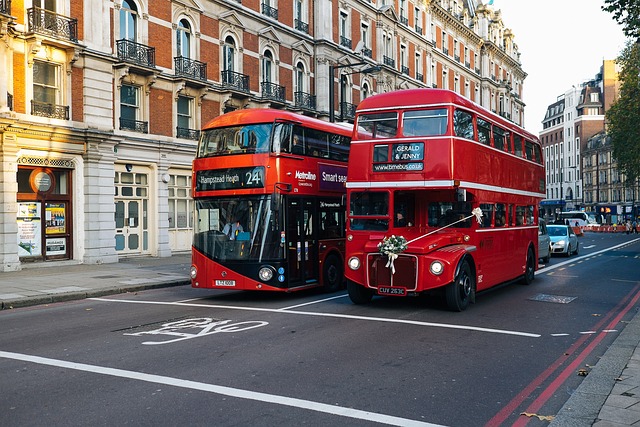Are you interested in finding out the weight of a double-decker bus? You might be shocked to realize that the solution is more complicated than you might anticipate.
Moreover, The weight of a double-decker bus is influenced by factors like size, construction materials, and intended use. On average, these buses may weigh around 12 to 18 tons. However, this is a broad estimate, as various factors such as manufacturer, engine type, passenger capacity, and additional features can cause significant weight variations.
For accurate details, read out the full article and also learn the benefits of double decker bus. essential.
What are the factors that influence the weight of a double decker bus?

Size and Dimensions: The dimensions of a bus, including its length, width, and height, significantly contribute to its overall weight. Larger buses inherently have more material and structural components, which can increase their mass.
Materials Used in Construction: The choice of materials for constructing the bus plays a pivotal role in determining its weight. Buses can be built using various materials such as steel, aluminum, and composite materials. Different materials have varying densities and structural properties, directly impacting the bus’s weight.
Seating Arrangement and Passenger Capacity: The number of seats and how they are arranged on both the upper and lower decks influence the weight of the bus. More seats and complex seating arrangements can add considerable mass.
Power Source and Engine Type: The type of engine, whether diesel, electric, hybrid, etc., along with its size and power, affects the overall weight of the bus. Larger and more powerful engines tend to contribute to higher mass.
Chassis and Frame Design: The design and construction of the chassis and frame play a role in the weight of the bus. A sturdy frame enhances safety but may also increase weight.
Interior Amenities and Features: Interior amenities such as air conditioning systems, entertainment setups, and other features add to the bus’s weight. Additionally, advanced safety features like impact-absorbing materials and enhanced braking systems can increase mass.
Accessibility and Passenger Convenience: Buses designed for accessibility may incorporate ramps, lifts, and mechanisms for passengers with disabilities. These additions can impact the bus’s dimensions and weight.
Regulations and Safety Standards: Design and structural components mandated by regional laws and safety standards can influence the weight of the bus. Compliance with regulations may introduce additional weight.
Technological Advancements: Ongoing technological advancements aim to reduce bus weight. Lightweight materials, energy-efficient components, and advanced production processes are being explored to lighten buses.
Powertrain Type: The choice of powertrain, such as battery systems or electric drivetrain components, in electric or hybrid buses brings specific weight considerations.
How much does a double decker bus weigh?
The make, model, and building materials used to construct a double decker bus weight can affect all the vehicles. However, a double-decker bus can often weigh between 10 and 16 tons.
For instance, in the UK, depending on the model, the weight of the famous red double-decker buses used in London ranges from 12 to 14 tons. Double-decker buses are less frequent in the United States, but they are still utilized for public transit and sightseeing tours in several locations.
What are the benefits of double-decker bus?

Numerous benefits of double-decker buses greatly improve urban mobility and transportation networks. The innovation successfully makes the most of available space, enhancing passenger capacity within a compact size and reducing traffic on city streets.
Again this increased seating capacity not only alleviates overcrowding but also improves passenger comfort, ensuring a smoother and more enjoyable travel experience for commuters. Moreover, the elevated upper decks of these buses provide passengers with unparalleled panoramic views of cityscapes and iconic landmarks, adding a touch of novelty and enhancing the appeal of urban tourism.
In addition, the adoption of electric or hybrid technology in buses aligns seamlessly with sustainability goals, effectively reducing emissions and contributing to a lower carbon footprint. Beyond its functional benefits, the double-decker bus holds cultural significance and often becomes an emblematic symbol of cities, imbuing the urban landscape with character and historical resonance.
Furthermore, these buses play a pivotal role in efficient commuting by seamlessly moving large numbers of people during peak hours, thereby reducing travel times and supporting more streamlined transportation networks.
A key advantage lies in the advertising potential that the exterior and interior spaces of buses offer, serving as valuable real estate for branding and advertising, and generating revenue for transit authorities or operators. Additionally, innovations in design and technology have led to improved passenger amenities, enhanced safety features, and increased energy efficiency.
Another key point is these buses’ versatility further emphasizes their value in contemporary urban mobility because they may be customized for a variety of uses, covering public transit and specialty services like school transportation.
FAQ
How tall is a double decker bus?
A double-decker bus typically ranges in height from around 13 to 15 feet (approximately 4 to 4.5 meters), depending on the specific model and design. These buses are often taller than standard single-decker buses to accommodate the additional upper deck.
What’s the cost of a double decker bus?
According to Dublin Bus, a tender is being used to sell the buses. The company was mum on the projected sale price of the buses, other than to say that the “new” pricing of such buses is in the region of €316,000.
What is a double-decker electric bus?
According to the company, the new electric buses can accommodate up to 80 passengers and are air conditioned, environmentally sustainable, and noiseless. For easier entry and exit, the e-bus has two staircases instead of the single one used in conventional double-decker buses.
What is the double-decker bus’s speed?
50mp. But the present fleet of double deckers can only go 50 mph at most because they were built primarily for city work. The speed of our Routemaster is about 40 mph. But the legal limit for all buses and coaches on single-carriageway roads is 50 mph.
Conclusion
Overall, the double-decker bus, an iconic symbol of urban transportation, stands as a testament to both functionality and design ingenuity. With its distinctive two-level structure, it offers a unique solution to the challenges of moving large numbers of passengers efficiently within bustling cityscapes. The weight of these buses, ranging from approximately 12 to 18 tons, holds a pivotal role in defining their performance, fuel efficiency, safety, and environmental impact.
Besides, As technologies continue to advance and urban populations grow, the weight consideration of double-decker buses will remain a compass guiding the path toward safer, more efficient, and more sustainable urban transportation systems.











